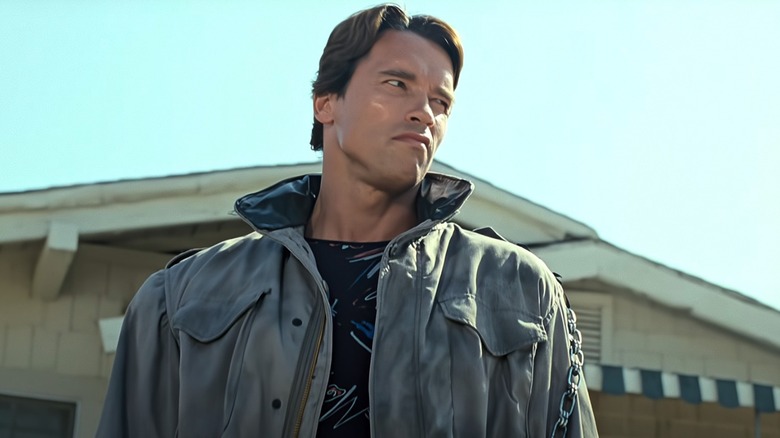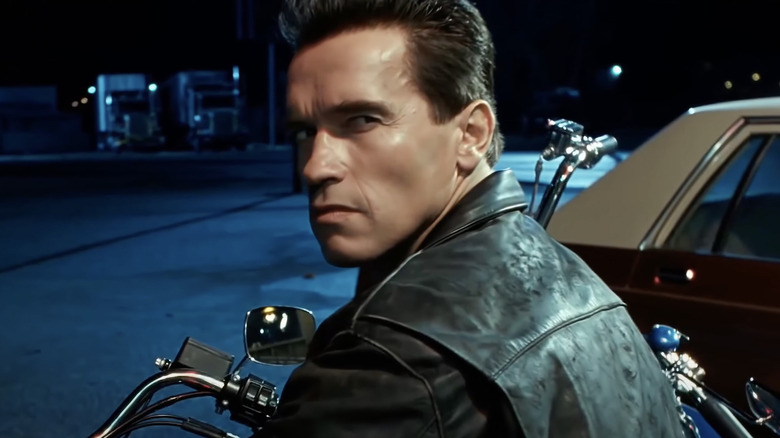The Right Way To Watch Every Terminator Movie In Order
Fresh off of his feature directorial debut, "Piranha Part Two: The Spawning," filmmaker James Cameron blew everyone away with 1984's "The Terminator," a hard-hitting, gritty sci-fi action flick starring Arnold Schwarzenegger as the Terminator, a T-800 cyborg who has been sent back in time to kill Sarah Connor (Linda Hamilton). Connor is the woman who will eventually give birth to John Connor, the leader of the resistance trying to destroy the sinister machines.
"The Terminator" quickly became a pop culture phenomenon, cementing Cameron's clout in Hollywood and allowing him to helm sci-fi classics like "Aliens" and "The Abyss" shortly thereafter. In 1991, the director returned to the franchise with the critically acclaimed "Terminator 2: Judgment Day," which grossed $205 million and is widely considered to be one of the best sequels of all time. Since then, the movies have struggled to reach those same critical heights, but that hasn't stopped creatives from trying to turn the series into a cash cow.
Today, "Terminator" is a full-blown multimedia franchise, consisting of video games, comic books, the acclaimed but short-lived television program "Terminator: The Sarah Connor Chronicles," and six live-action theatrical films. It can be hard to figure out just how newcomers should approach the series since one of its key themes is time travel, but ultimately, there are two orders in which both fans and newcomers can watch the movies — one just makes more sense than the other.
Watch the Terminator movies in the correct order
The best way to watch the "Terminator" movies is in the order they came out. Enjoying them this way allows audiences to recognize two things: how the franchise evolved, from both a narrative and a spectacle perspective, and how to understand the convoluted timeline in a more digestible manner. Eventually, the movies diverge into different timelines and even attempt to retcon previous entries in the series, rendering some moot.
- "The Terminator" (1984)
- "Terminator 2: Judgment Day" (1991)
- "Terminator 3: Rise of the Machines" (2003)
- "Terminator Salvation" (2009)
- "Terminator Genisys" (2015)
- "Terminator: Dark Fate" (2019)
While "The Terminator" and "Judgment Day" are widely heralded as some of the best sci-fi flicks of all time, the same can't be said for the sequels. "Rise of the Machines" is an interesting follow-up in that it features an adult John Connor (Nick Stahl), but after that, things get a bit murky plot- and timelines-wise.
McG's "Salvation," which bombed at the box office, focuses on John Connor's (Christian Bale) efforts to destroy Skynet. It is considered a reboot of sorts and was made without the involvement of Arnold Schwarzenegger. Meanwhile, "Genisys" follows an altered timeline that plays with "The Terminator" — a clear example of the legacy sequel — and "Dark Fate" ultimately retcons everything after the first two movies, serving as the definitive third chapter in the franchise.
The messy chronological order of the Terminator movies
Another way to watch the "Terminator" movies is chronologically, which adds context to the broader mythos but is a bit challenging since they eventually veer into alternate timelines. This coupled with the fact that the series takes place over a wide range of years may make it difficult for new fans to fully get on board with the vision that's at work, and the nuances that watching the movies in this order brings will mostly be appreciated by fans who have already seen them.
- "The Terminator" (1984)
- "Terminator 2: Judgment Day" (1991)
- "Terminator: Dark Fate" (2019)
- "Terminator 3: Rise of the Machines" (2003)
- "Terminator Salvation" (2009)
- "Terminator Genisys" (2015)
Watching the movies in chronological order yields an interesting experience. Again, things become increasingly complicated after the James Cameron-directed duology, with "Dark Fate" taking place decades after "Judgment Day" and ignoring the events of the other three sequels, which essentially makes them supplementary material. From here, the chronological order again follows the release order.
Although "Genisys" technically takes place in 1984, concurrent with the events of the original film, it leans heavily into alternate timelines and eventually pivots to the present day. Moreover, the release of "Dark Fate" ultimately renders its existence moot, so it serves as more of a "what if?" scenario rather than a proper sequel, which is why it's the final movie in chronological order.


